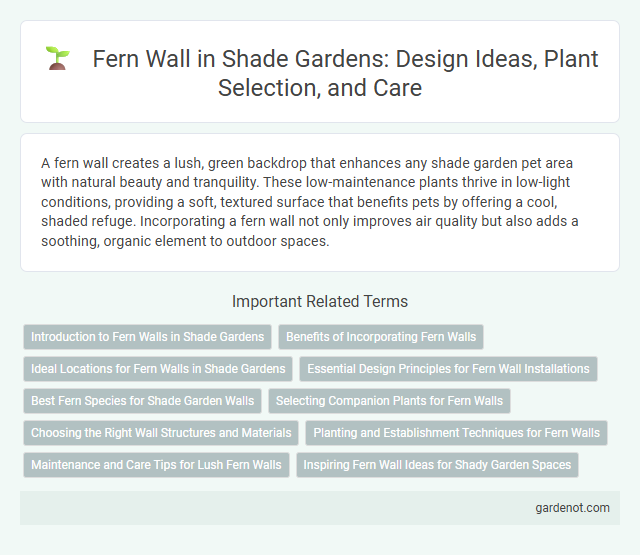A fern wall creates a lush, green backdrop that enhances any shade garden pet area with natural beauty and tranquility. These low-maintenance plants thrive in low-light conditions, providing a soft, textured surface that benefits pets by offering a cool, shaded refuge. Incorporating a fern wall not only improves air quality but also adds a soothing, organic element to outdoor spaces.
Introduction to Fern Walls in Shade Gardens
Fern walls create lush, vertical green spaces that thrive in shade gardens by utilizing ferns' natural preference for low-light, high-humidity environments. These living walls enhance garden aesthetics while improving air quality and providing habitat for beneficial insects. Ideal ferns for these installations include Boston fern, Maidenhair fern, and Japanese painted fern, which adapt well to indoor and outdoor shade conditions.
Benefits of Incorporating Fern Walls
Fern walls enhance shade gardens by improving air quality through natural filtration and increasing humidity levels that support moisture-loving plants. They provide a lush, textured backdrop that promotes biodiversity by attracting beneficial insects and small wildlife. Incorporating fern walls also aids in noise reduction and cooling effects, creating a tranquil microenvironment ideal for shaded outdoor spaces.
Ideal Locations for Fern Walls in Shade Gardens
Fern walls thrive in shade gardens with consistent moisture and well-drained soil, making them ideal for north-facing walls or under dense tree canopies. These locations provide the cool, humid environments that promote lush fern growth while protecting delicate fronds from direct sunlight. Incorporating fern walls near shaded patios or along garden paths enhances natural aesthetics and creates tranquil, green retreats.
Essential Design Principles for Fern Wall Installations
Fern wall installations require careful consideration of lighting, moisture levels, and plant selection to thrive in shade garden environments. Ensuring consistent humidity and indirect light supports fern health while using a waterproof backing prevents structural damage. Integrating diverse fern species with varying textures enhances visual depth and promotes a balanced, sustainable living wall ecosystem.
Best Fern Species for Shade Garden Walls
Best fern species for shade garden walls include Dryopteris erythrosora (Autumn Fern) for its vibrant coppery new fronds, Polystichum munitum (Western Sword Fern) with its bold, arching fronds providing dense coverage, and Adiantum pedatum (Maidenhair Fern) valued for its delicate, lacy foliage. These ferns thrive in low-light, moist environments and create lush, textured green walls that enhance shade gardens. Selecting species with varying frond shapes and colors can add depth and visual interest to your shade wall design.
Selecting Companion Plants for Fern Walls
Selecting companion plants for fern walls involves choosing shade-tolerant species that thrive in similar moisture and soil conditions, such as hostas, astilbes, and heucheras. These plants enhance the visual texture and depth of the fern wall while promoting a healthy ecosystem by attracting beneficial insects and maintaining humidity. Combining ferns with broad-leafed or flowering companions creates a dynamic, layered shade garden that maximizes aesthetic appeal and plant health.
Choosing the Right Wall Structures and Materials
Selecting the right wall structures for a fern wall involves prioritizing materials that retain moisture and withstand humid conditions, such as treated wood or composite panels. Lightweight metal frames with protective coatings provide durability while supporting lush vertical growth in shaded environments. Incorporating breathable fabrics or mesh backing enhances air circulation, essential for maintaining healthy fern fronds and preventing mold buildup.
Planting and Establishment Techniques for Fern Walls
Fern walls thrive in well-drained, humus-rich soil enriched with organic matter to retain moisture and support root growth. Select shade-tolerant fern species such as maidenhair, Boston, or bird's nest ferns, and plant them closely using a modular panel system to create dense, lush coverage. Maintain consistent humidity, provide indirect light, and incorporate misting or drip irrigation to ensure successful establishment and long-term health of the fern wall.
Maintenance and Care Tips for Lush Fern Walls
Maintaining a lush fern wall requires consistent moisture, as ferns thrive in humid, well-watered environments with evenly moist soil to prevent drying out. Regularly misting the fronds and ensuring proper shade with filtered light helps ferns retain their vibrant green color and promotes healthy growth. Periodic pruning of dead or yellowing leaves combined with balanced fertilization supports the overall vitality of the fern wall.
Inspiring Fern Wall Ideas for Shady Garden Spaces
Create a stunning fern wall in shady garden spaces by combining a variety of fern species such as Boston fern, maidenhair fern, and ostrich fern for diverse textures and shades of green. Use vertical planters or modular wall systems to maximize space and ensure proper drainage and humidity for thriving ferns. Incorporating moss and small shade-loving plants like hostas or ivies will enhance the lush, tranquil appeal of your fern wall, transforming any shaded area into a vibrant living masterpiece.
Fern wall Infographic

 gardenot.com
gardenot.com